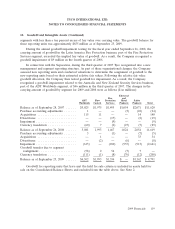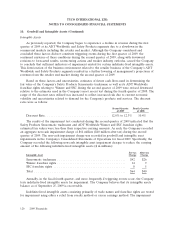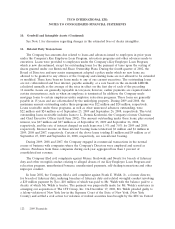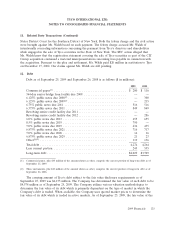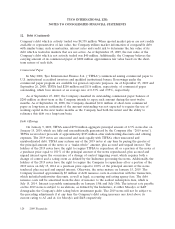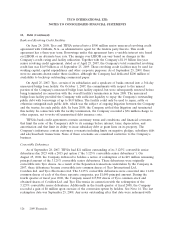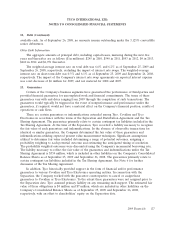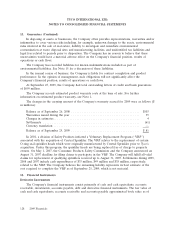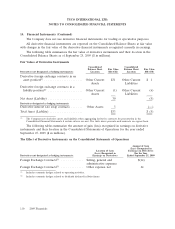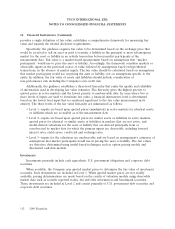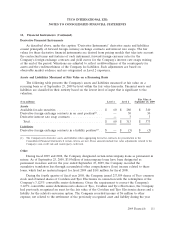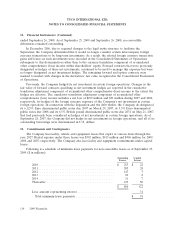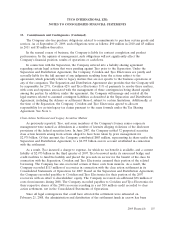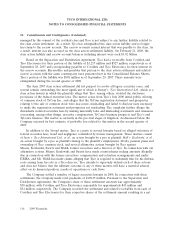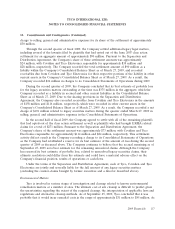ADT 2009 Annual Report Download - page 221
Download and view the complete annual report
Please find page 221 of the 2009 ADT annual report below. You can navigate through the pages in the report by either clicking on the pages listed below, or by using the keyword search tool below to find specific information within the annual report.TYCO INTERNATIONAL LTD.
NOTES TO CONSOLIDATED FINANCIAL STATEMENTS
14. Financial Instruments (Continued)
September 25, 2009. See below for the fair value of derivative financial instruments. See below and
Note 9 for Investments and Note 12 for Debt.
In the normal course of business, Tyco is exposed to market risk arising from changes in currency
exchange rates, interest rates and commodity prices. The Company uses derivative financial instruments
to manage exposures to foreign currency and interest rate risks. The Company’s objective for utilizing
derivative financial instruments is to manage these risks using the most effective methods to eliminate
or reduce the impacts of these exposures. The Company does not utilize derivative financial
instruments to hedge its exposure attributable to changes in commodity prices but may consider such
strategies in the future.
The Company manages foreign currency exchange rate risk through the use of derivative financial
instruments comprised principally of forward contracts on foreign currency which are not designated as
hedging instruments for accounting purposes. The objective of those derivatives instruments is to
minimize the income statement impact and potential variability in cash flows associated with
intercompany loans and accounts receivable, accounts payable and forecasted transactions that are
denominated in certain foreign currencies. Effective March 17, 2009, Tyco changed its jurisdiction of
incorporation from Bermuda to Switzerland. Until January 1, 2011 Tyco intends to make dividend
payments in the form of a reduction of capital, denominated in Swiss francs. However, the Company
expects to actually pay dividends in U.S. dollars, based on exchange rates in effect shortly before the
payment date. Fluctuations in the value of the U.S. dollar compared to the Swiss franc between the
date the dividend is declared and paid will increase or decrease the U.S. dollar amount required to be
paid. The Company manages the potential variability in cash flows associated with the dividend
payments by entering into derivative financial instruments used as economic hedges of the underlying
risk.
The Company manages interest rate risk through the use of interest rate swap transactions with
financial institutions acting as principal counterparties, which are designated as fair value hedges for
accounting purposes. During 2009, the Company entered into interest rate swap transactions with the
objective of managing the exposure to interest rate risk by converting the interest rates on $1.4 billion
of fixed-rate debt to variable rates. In these contracts, the Company agrees with financial institutions
acting as principal counterparties to exchange, at specified intervals, the difference between fixed and
floating interest amounts calculated on an agreed-upon notional principal amount.
For derivative instruments that are designated and qualify as fair value hedges, the Company
documented the relationships between the hedging instruments and hedged items and linked derivatives
designated as fair value hedges to specific debt issuances. For transactions designated as hedges, the
Company also assessed and documented at the hedge’s inception whether the derivatives used in
hedging transactions were effective in offsetting changes in fair values associated with the hedged items.
The Company will continue to assess hedge effectiveness on an on-going basis. The fair value hedges
did not result in any hedge ineffectiveness for the year ended September 25, 2009.
The Company terminated certain interest rate swaps in the first quarter of 2007 that were
outstanding at that time. Since the interest rate swaps were designated as hedging instruments of
outstanding debt, the related loss was to be amortized over the remaining life of the related debt
instruments. During the year ended September 26, 2008, in connection with the debt tender offer,
$9 million of unamortized loss on interest rate swaps was accelerated and recorded as a loss on
retirement of debt and included in other expense, net. See Note 12.
2009 Financials 129


